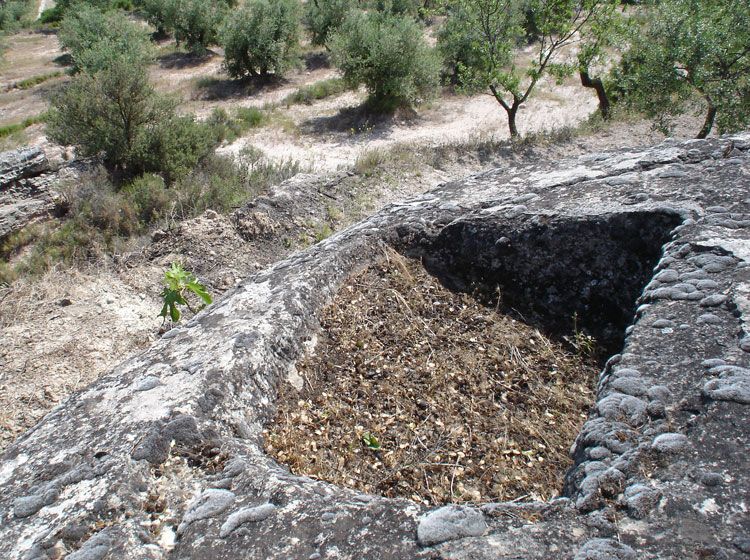Dry stone in Catalonia
The shores of the Mediterranean are among the areas of the world with the largest presence of dry stone elements. The durability of the material used (fundamentally limestone) and the scarcity of spontaneous vegetation in the areas where they abound (the result of poor rainfall) have contributed to the preservation of many of these constructions: walls, vineyard huts, vaulted cabins, ponds, windbreaks, etc. In fact, the southern part of Catalonia, the Balearic Islands, and the northern part of Valencia constitute one of the largest collections of dry stone on the Mediterranean shore.
The presence of dry stone in Catalonia is found more tangibly in Camp de Tarragona, the Penedès, the dry areas of the Garrigues, Urgell, the Segria, the Ribera d’Ebre, the Terra Alta and the Montsia, among others.
Visit the Wikipedra website:
Values in the landscape
The dry stone constructions have great historic value and are a true identifying feature in many territories where they predominate. In this context, throughout the centuries they have shaped many agricultural and livestock farming landscapes of great value, dominated above all by olive groves, vineyards, almond orchards and cereals, fully adapted to the soils and climate.
Dry stone walls, on the other hand, besides forming terraces or delimiting parcels, are rich ecosystems for many animal species (insects and invertebrates, amphibians, reptiles and small mammals and also some species of birds which nest in them) and plants (brackens, lichens and mosses).
Architecture for the conditioning of properties in Catalonia
Throughout history, many generations have extracted from what were to become cultivated fields the stones which hindered the ploughing and the proper growth of the crops. These stones were used to build the terraces of cleared areas and the dry stone walls which protected and edged the fields and, in some cases, also the properties.
Terraces
The dry stone barriers held the slopes thus forming terraces, and this made it possible to gain cultivable land in places where before the slope made it difficult. These constructions helped to halt the flow of rainwater, thus retaining the moisture and preventing erosion. Terracing is the simplest and at the same time the most common element of the dry stone heritage.
Walls built from collected stones
Pulling stones out of the fields was for many generations a job which filled spare time with purpose and was often translated into the construction of terraces and walls. In this way the land was made cultivable and at the same time it fulfilled a triple function: dividing the property, storing scree and, on sloping land, shaping terraces or steps which would then be filled with soil and could be used for cultivation. In places where the architecture of the false cupola exists, the existence of the cabin or hut also answered to this need to remove the stones from the field.

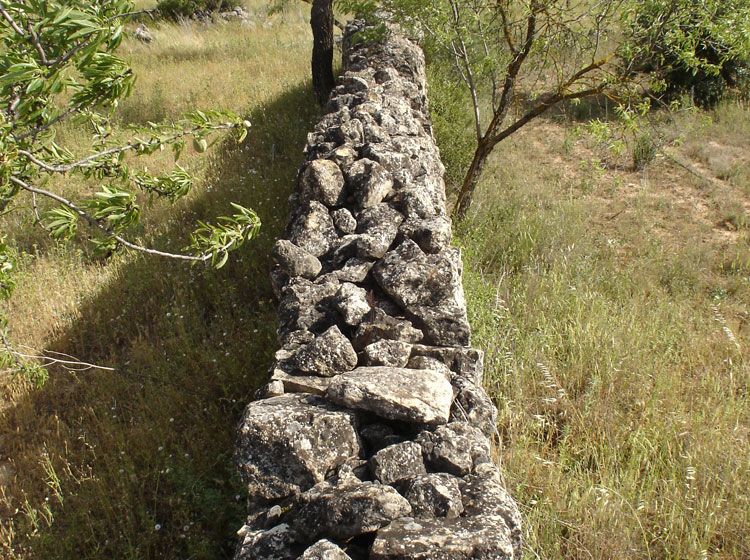
Architecture supporting people and animals in Catalonia
This relates to constructions which functioned as shelters for tools and places for resting. The peasants used them when the field work required them to stay out for long spells and to protect themselves from storms when the properties were far from the urban centre. If size allowed, they were also used as a place of rest for the draught animals. With the arrival of tractors and cars, these constructions have gradually lost their original function. On the other hand, the surroundings of the cabins and huts was generally the part of the property chosen to locate the various shade trees which, for their greater size, have become reference points in a landscape dominated by rather low-growing plant cover.
Vineyard huts
This is the most common type of construction around the Mediterranean. In Catalonia, these huts are found in the central districts, Camp de Tarragona and all along the coast, in great numbers. Probably their building technique, the system of approximation of rows, is very ancient. The technique consists of placing the stones horizontally on top of one another, without polishing, levelled, well fitted together and with a slight incline for the rainwater to run off. The top rows lean towards the interior, forming rings of stone of decreasing radius towards the cupola, which is closed with one or several slabs. Sometimes, a layer of earth and clay was applied over the top, even with plants to bind it together, such as bearded irises (Iris germanica).
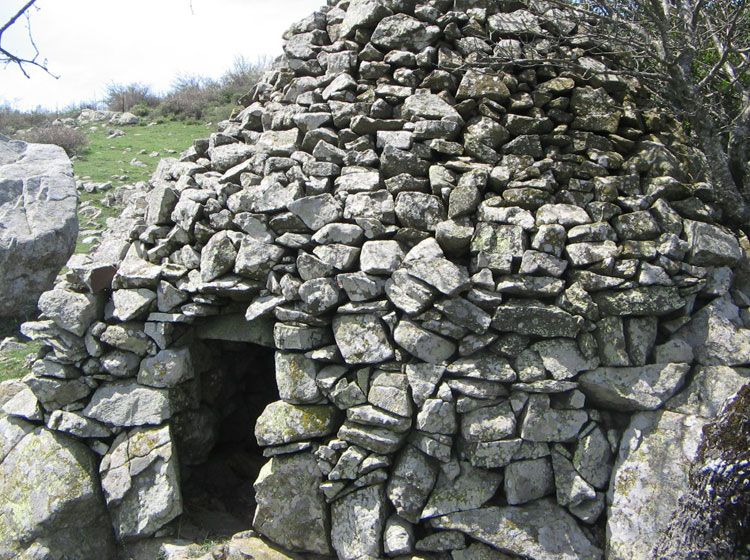
Vaulted cabins
These constructions were made mostly during the 19th century in the area of the Garrigues, Urgell, the Segarra and the Terra Alta. Normally they are built on sloping land with consecutive rows of ashlar slabs forming a semicircular arch and with the façade incorporated after the vault had been closed. When the structure is complete, natural earth is added on top to make it waterproof. The floor generally has an area of between 15 and 35 square metres and there is a single door – occasionally with a vent upwards – without a window.
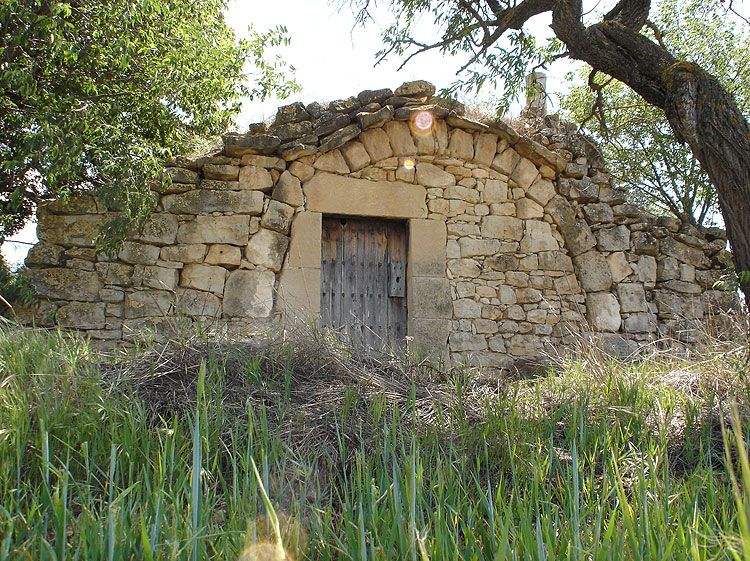


Walled shelters
By walled shelters we mean natural caves which were made habitable for occupation by building a dry stone wall on the outside with an access and normally with an outlet for smoke. In some areas we find walled shelters of large size which were used as corrals for livestock.

Tiled cabins
Tiled cabins is the name given to constructions on a square or rectangular plan, with dry stone walls and a tiled roof, lean-to or ridged. Their large size, openings, distribution and other characteristics are very variable. After the terraces, these are the most common dry stone units built in the environment of the peninsular coast between the end of the 19th century and the first half of the 20th century, the time in which ceramic materials began to be used.
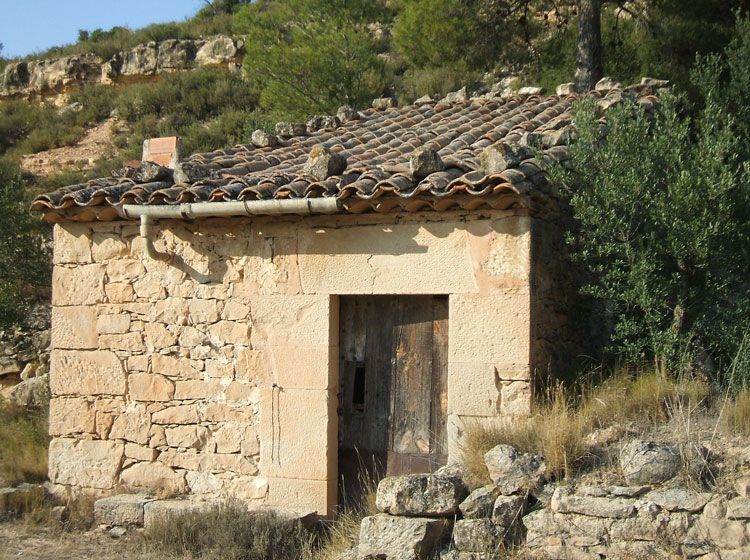
Shelters and windbreaks
These are simple constructions conceived for protection from the wind, formed by a simple dry stone wall. They are found in various forms – circular, horseshoe, square, rectangular – generally with the entrance located on the opposite side to the dominant wind. They may be isolated or attached to a cabin or hut as a prolongation of the outside wall.
Dry stone used for water storage in Catalonia
In the Mediterranean basin, with its irregular and often scarce rainfall, it was essential to have water available, above all for the people, the animals and the crops. Dry stone is once again the resource used to make ponds or similar constructions in order to save rainwater.
Ponds
The pond is a rudimentary deposit in the open air, uncovered. Ponds are on a flat circular base with a side wall in dry stone, although in some cases (probably more recent) the shape is square or rectangular. The substratum of the base was usually clay, a material almost impermeable. Normally there was access to the interior by steps, either at the side by the wall or perpendicular to the circle in a ramp leading to the bottom. The steps were used to fetch water when the level was low and to clean the bottom from time to time, where dirt and impurities carried by the water had collected. To prevent the entry of small creatures a wall was raised around the pond and, in some cases, was covered with a false cupola.
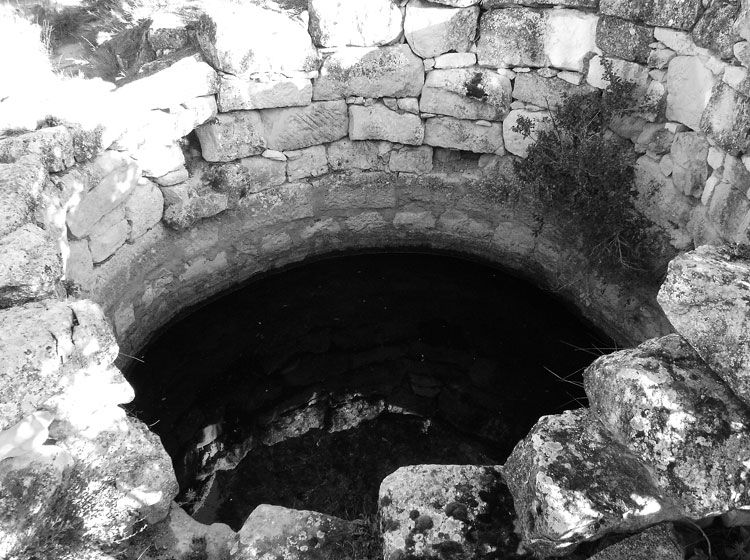
Cisterns and tanks
Cisterns and tanks are smaller deposits, advanced and artificial, formed by an underground basin of square or rectangular base, covered and topped by a kind of closed cabin with a small metal or wooden door at waist height, where a person could lean in to collect water from the interior with a bucket. In cisterns the internal pool was excavated in the land or bank or was fitted in a natural concavity in the rock or a specially excavated hollow. The water spout or cabin, similar to the outside of a well, shows very varied forms and different techniques, varying from a simple construction on a square or rectangular base in ceramic work to a raised cylindrical floor with a false cupola, passing by the troncoconical shape covered with slabs and clay, among others. There were two orifices: one for the entry of the water which was collected from outside over the rock or other smooth surface, and the other as an overflow.
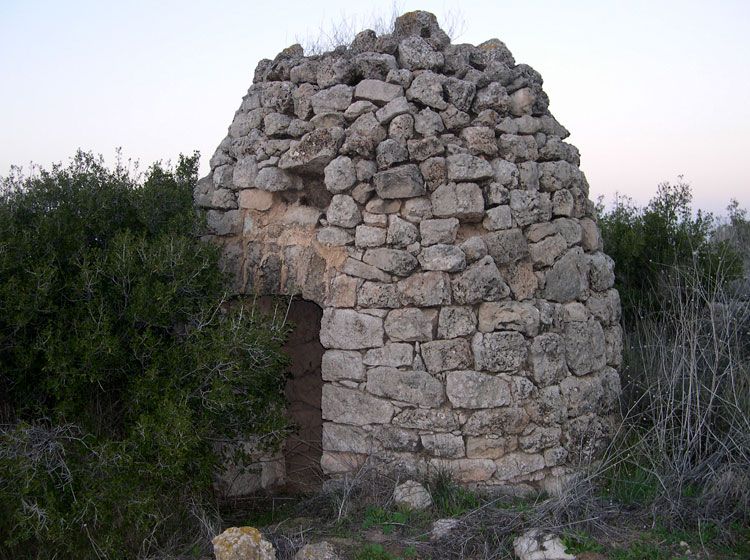
Pools (cogulles and cadolles)
Pools (cogulles and cadolles) are a third type of deposit, fairly unusual. Normally rectangular, they are excavated in the rock. They are always located in the lower part of a rocky surface, more or less broad, fed by channels worked in the stone and leading into the deposit. To prevent evaporation and the intrusion of animals, they were covered with a metal or wooden lid.
